
The Bottom Line
Introduction, Specifications, Pricing & Availability
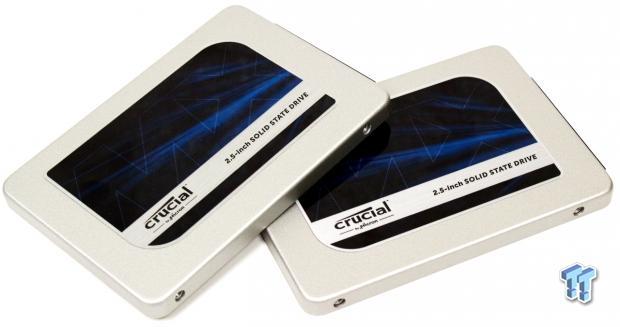
We've been waiting for the right moment to drop this review and that time is now. Pricing for solid state storage is on the rise due to the current NAND-flash shortage. And this is where Crucial's MX300 is at its most appealing. The 2TB MX300 is by far the lowest-cost high-capacity SSD on the market. It is a massive $150 less than you will pay for the only real competition in town; Samsung's 2TB 850 EVO. In addition to being way cheaper than the EVO, the 2TB MX 300 is actually 2050GB. So, with the 2TB MX300, you are getting an additional 50GB of usable space over the 2TB 850 EVO.
We see Crucial's high-capacity MX300 SSDs as the ideal storage device for those that need high-capacity storage and are also looking to free themselves completely from archaic mechanical storage. A single 2TB MX300 should for most; hold their entire steam library and at the same time deliver performance that is light-years ahead of any mechanical disk.
As with all modern TLC SSDs, the MX300 employs pSLC (pseudo single-level cell) caching to boost burst performance. Crucial calls their pSLC technology Dynamic Write Acceleration. Dynamic Write Acceleration technology uses an adaptable pool of high-speed, single-level cell flash memory to generate blistering speeds throughout the life of the drive. If you are looking for even more burst performance, you can do so through Crucial's Storage Executive software suite. Storage Executive is a downloadable tool that is easy to use and helps monitor and enhance the performance of your Crucial MX300. The Momentum Cache feature in Storage Executive enables DRAM caching of your Crucial SSD.
In addition to being orders of magnitude faster than any mechanical HDD, the MX300 is more power efficient, more reliable and more enduring than mechanical HDDs; making MX300 ideal for laptops and notebooks. The Crucial MX300 extends your laptop's battery life by using only 0.075W of power, compared to a typical hard drive which uses 6.8W.
We believe that Crucial's high capacity MX300 models are currently the best value in high-capacity solid state storage, now let's take a close look at the performance they have to offer:
Specifications
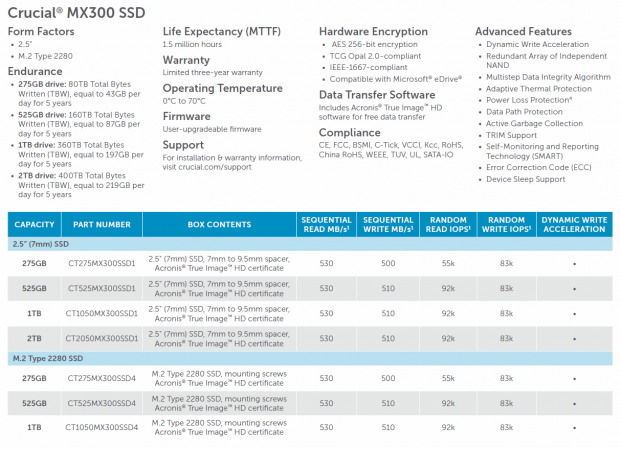
Crucial MX300 1050GB & 2050GB:
- Sequential Read: up to 530 MB/s
- Sequential Write: up to 510 MB/s
- Max 4K Random Read Speed: up to 92,000 IOPS
- Max 4K Random Write Speed: up to 83,000 IOPS
- Endurance: 1050GB up to 360TB, 2050GB up to 400TB
- MTTF: 1.5 Million Hours
- Warranty: 3-Year Limited Warranty
- DEVSLP
- ECC:
- SMART
- TRIM
- Garbage Collection
- Software: Acronis, Storage Executive
- Accessories 2.5mm stick-on spacer
Current Pricing: 1050GB = $289.99, 2050GB = $549.99
Drive Details
Crucial MX300 SATA III SSD
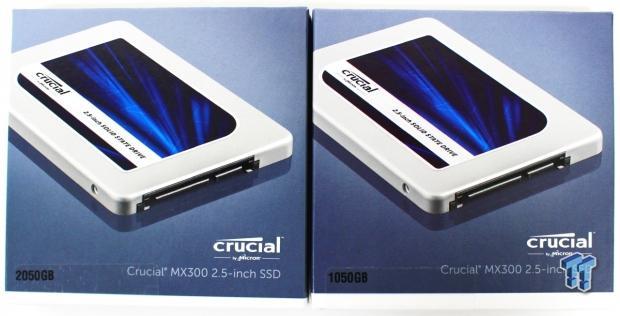
In typical Crucial fashion, the MX300 ships in a flip top box. The top of the packaging is blue themed, features an image of the drive and informs us of the enclosed drive capacity in gigabytes.
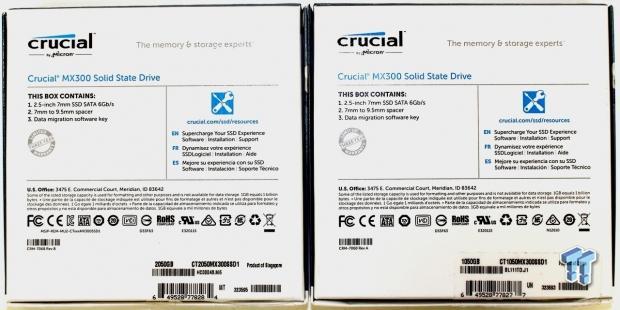
The back of the flip top box is all white. The contents of the packaging are listed, and the drive's limited three-year warranty is advertised.

Inside of the box, the drive itself is cradled in a clear plastic tray for protection. Crucial includes a stick-on plastic spacer and a printed download guide with an Acronis HD key.
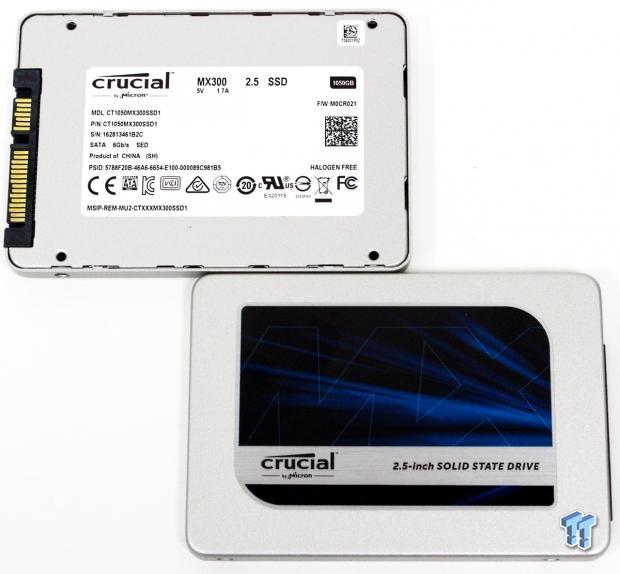
The top half of the drive's all-aluminum enclosure features a colorful manufacturer's label. The bottom half of the drive's enclosure features another manufacturers label that lists the drive's model number, serial number, shipping firmware and PSID number along with other various bits of relevant information.
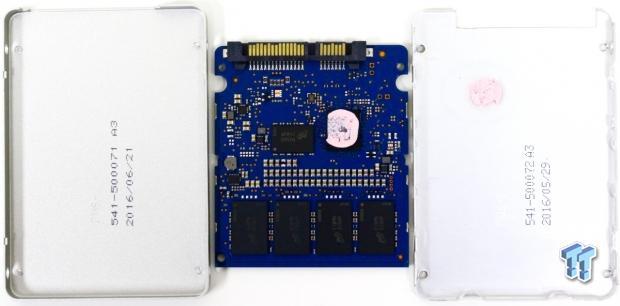
Liberating the drives PCB from its enclosure is no easy task. Because of the difficulty of opening the MX300, we decided to only open one. We assume both PCB's are identical with the only difference between the two capacities being double the density packages on the 2050GB model. The PCB itself snaps into the enclosure and the enclosure snaps together. The MX300 is a completely screwless design. The blue colored PCB is a 3/4 length design.
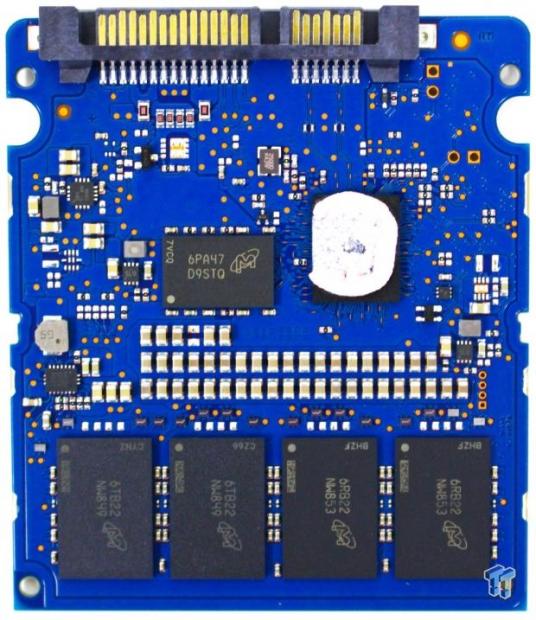
This side of the PCB houses four Micron 3D TLC flash packages, the drive's Marvell 88SS1074 4-channel controller and one Micron DRAM cache package. We decided against removing the glob of thermal paste on the controller to get a photo, as we did not want to compromise its thermal integrity.
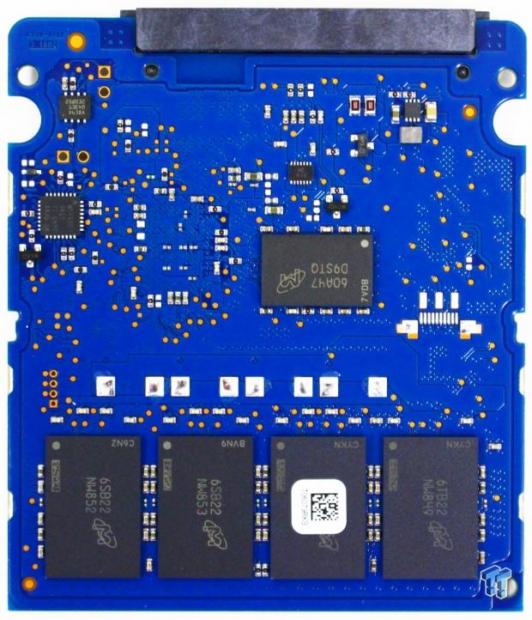
This side of the PCB houses an additional four Micron 3D TLC flash packages and another Micron DDR3 1600MHz DRAM package.
Test System Setup and Properties
Jon's Consumer SSD Review Test System Specifications
- Motherboard: ASRock Extreme9 Z97 - Buy from Amazon
- CPU: Intel Core i7 4790K @ 4.8GHz - Buy from Amazon / Read our review
- Cooler: Swiftech H2O-320 Edge - Buy from Amazon / Read our review
- Memory: Corsair Dominator DDR3 32GB 2400MHz - Buy from Amazon
- Video Card: Onboard Video
- Case: IN WIN X-Frame - Buy from Amazon / Read our review
- Power Supply: Seasonic Platinum 1000 Watt Modular - Buy from Amazon / Read our review
- OS: Microsoft Windows 10 Professional 64-bit - Buy from Amazon
- Drivers: Intel RAID option ROM version 13.0.0.2075 and Intel RST driver version 14.8.0.1042
We would like to thank ASRock, Crucial, Intel, Corsair, RamCity, IN WIN, and Seasonic for making our test system possible.
Drive Properties
Crucial MX300 2050GB OS Disk 75% Full
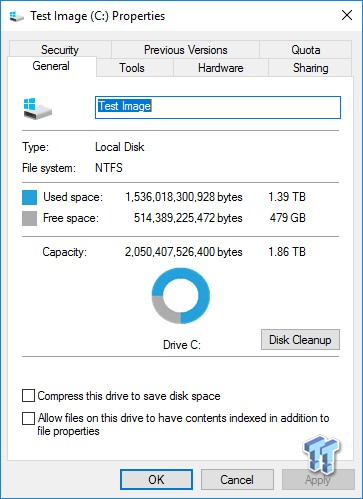
The majority of our testing is performed with our test drive as our boot volume. Our boot volume is 75% full for all OS Disk "C" drive testing to replicate a typical consumer OS volume implementation. We feel that most of you will be utilizing your SSDs for your boot volume and that presenting you with results from an OS volume loaded up with data is more relevant than presenting you with empty secondary volume results.
System settings: Cstates and Speed stepping are both disabled in our systems BIOS. Windows High-Performance power plan is enabled. Windows write caching is enabled, and Windows buffer flushing is disabled. We are utilizing Windows 10 Pro 64-bit OS for all of our testing except for our MOP (Maxed-Out Performance) benchmarks where we switch to Windows Server 2008 R2 64-bit.
We will be charting both capacity points and presenting benchmark screenshots for the 2050GB model.
Synthetic Benchmarks - ATTO & Anvil's
ATTO
Version and / or Patch Used: 2.47
ATTO is a timeless benchmark used to provide manufacturers with data used for marketing storage products. With ATTO, we are looking at maximum sequential performance with compressible data as well as the performance curve.
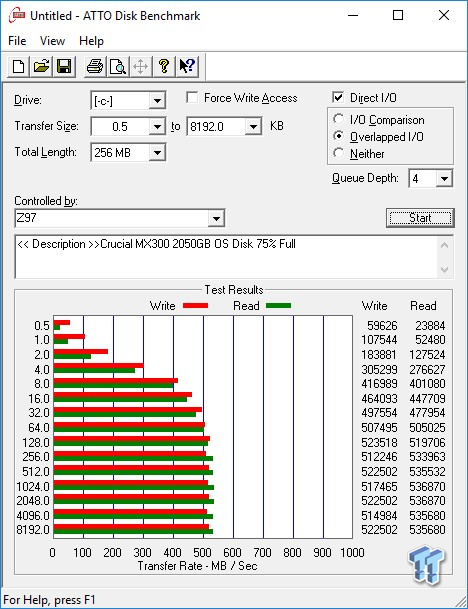
Sequential Write
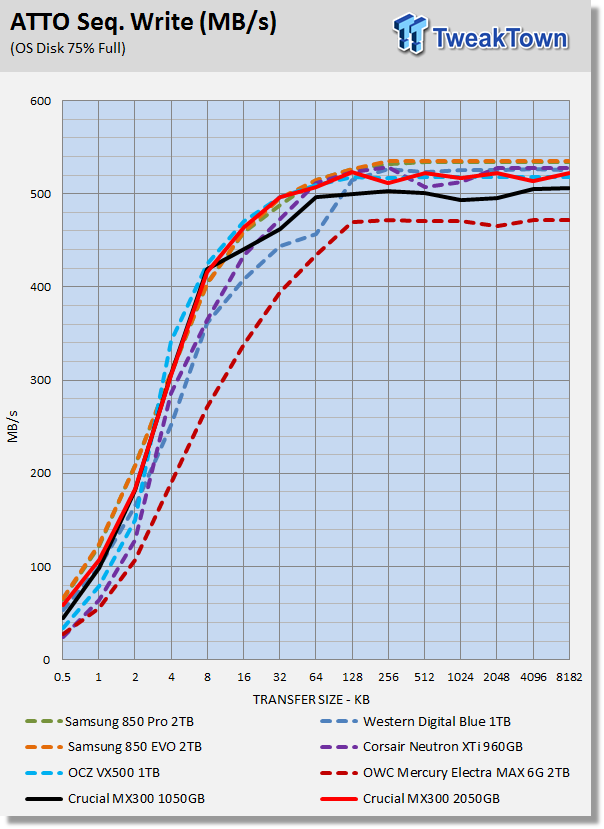
Both capacities deliver sequential write performance that is at or above factory spec. The 2TB model delivers better performance than the 1TB model. Both capacities display an excellent performance curve on the low-end where it matters most.
Sequential Read
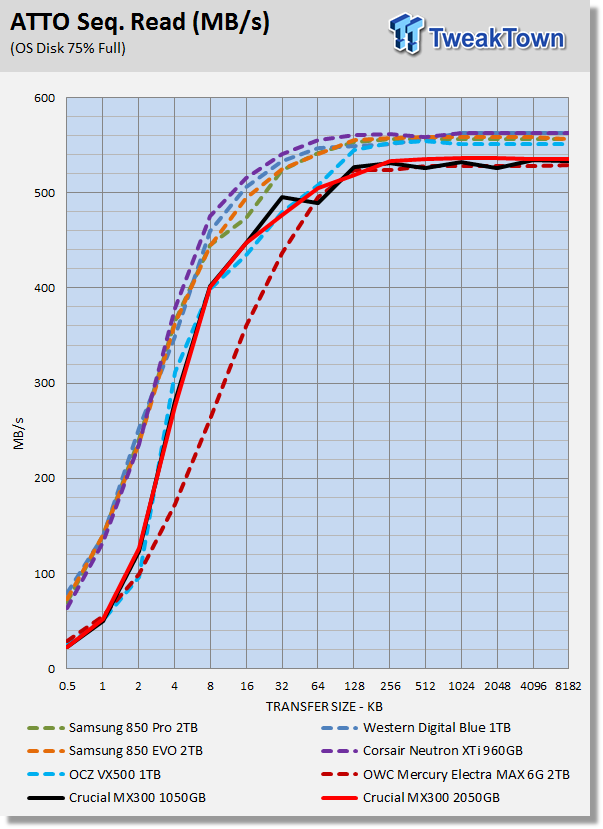
Both capacity points achieve their rated sequential performance. The performance curve of both capacities is similar. The MX300 is a write-centric SSD as we can clearly see from the results of this test. The majority of the competing SSDs in our test pool outperform the MX300 when reading sequential data.
Anvil Storage Utilities
Version and / or Patch Used: 1.1.0
Anvil's Storage Utilities is a storage benchmark designed to measure the storage performance of SSDs. The Standard Storage Benchmark performs a series of tests; you can run a full test or just the read or write test, or you can run a single test, i.e. 4K QD16. With Anvil's, we are focused on the total score.
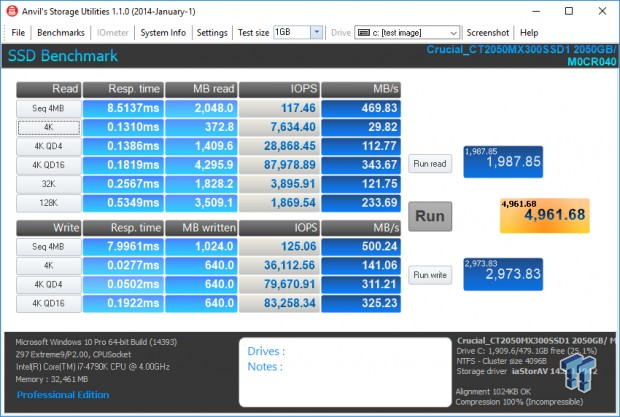
Scoring
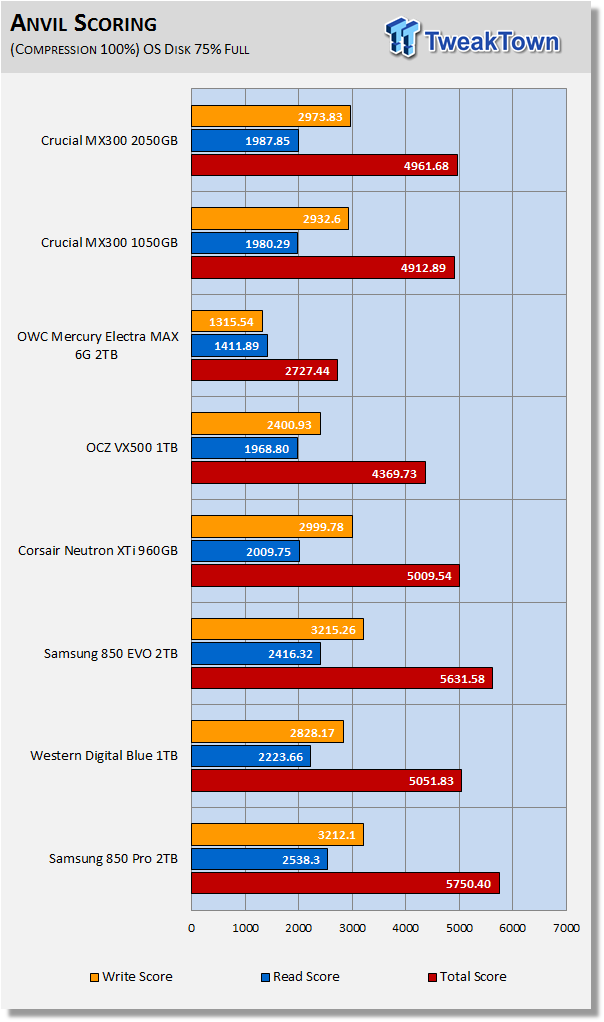
Anvil's scoring typically provides us with a good indication of a drive's overall synthetic performance. When evaluating TLC-based SSDs, we are looking for a minimum score of 4,500. Both capacity points give us what we are looking for; and then some.
(Anvil) Read IOPS through Queue Depth Scale
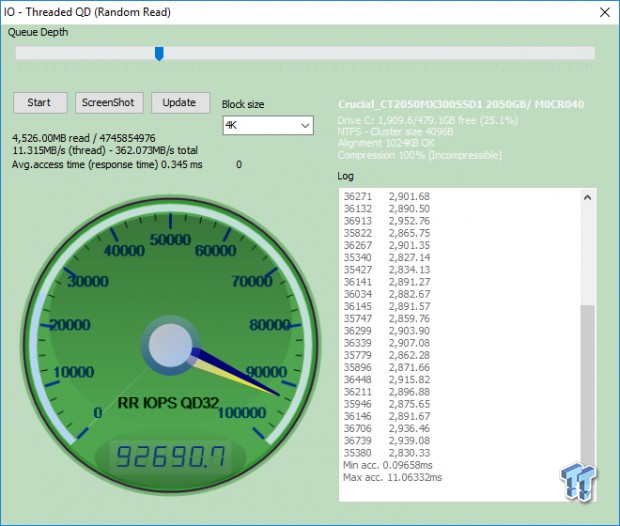
We are hitting factory spec at QD32 even when the drives are 75% full.
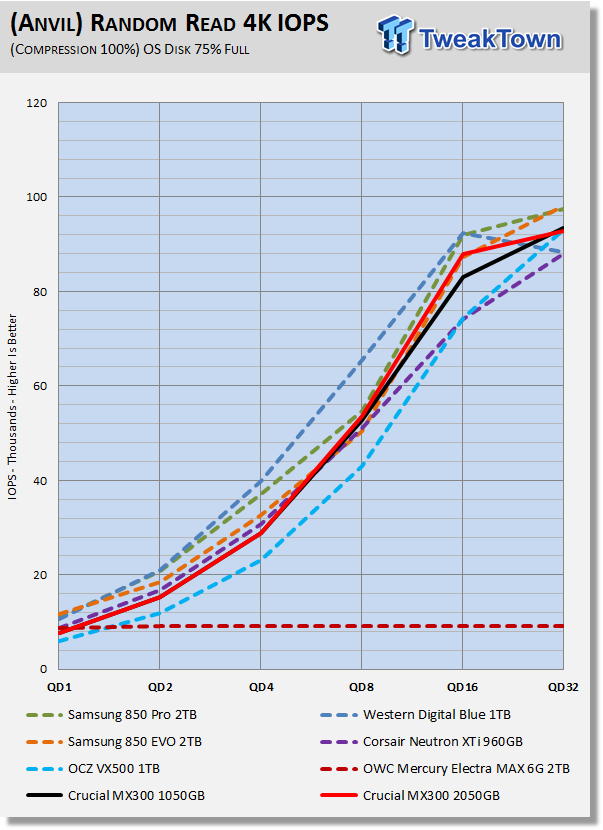
The MX300 runs at the low-end of the test pool when reading data at lower queue depths. This is as expected for a write-centric SSD. At higher queue depths, the MX300 comes on strong.
(Anvil) Write IOPS through Queue Scale
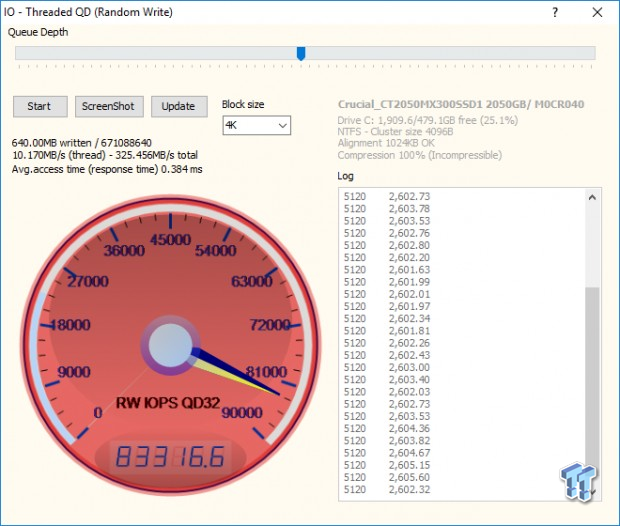
We are hitting factory spec at QD32 even when the drives are 75% full.
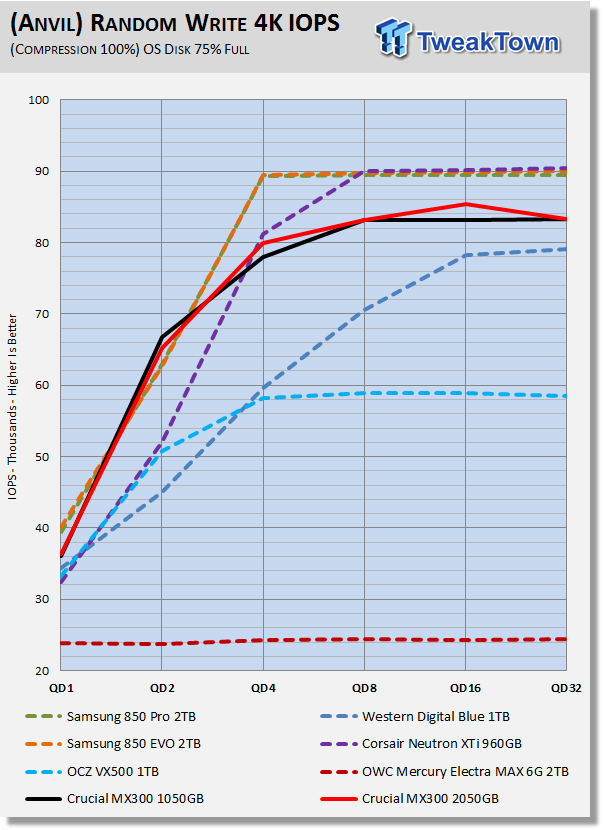
Low queue depth performance is what we are looking for, and this is where we find the MX300 delivering excellent performance. In fact, at QD2 the MX300 at both capacity points is leading all contenders in our test pool.
Synthetic Benchmarks – CDM & AS SSD
CrystalDiskMark
Version and / or Patch Used: 3.0 Technical Preview
CrystalDiskMark is disk benchmark software that allows us to benchmark 4k and 4k queue depths with accuracy. Note: Crystal Disk Mark 3.0 Technical Preview was used for these tests since it offers the ability to measure native command queuing at QD4. With this version of CDM, we are focused on 4K random performance at QD1 and QD4.
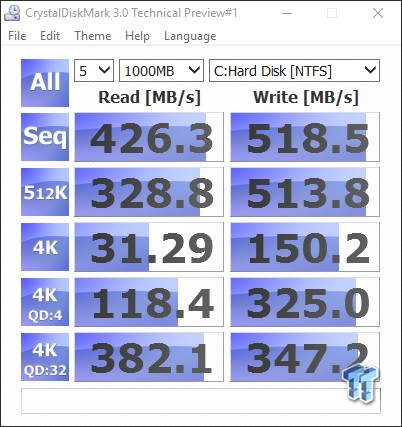
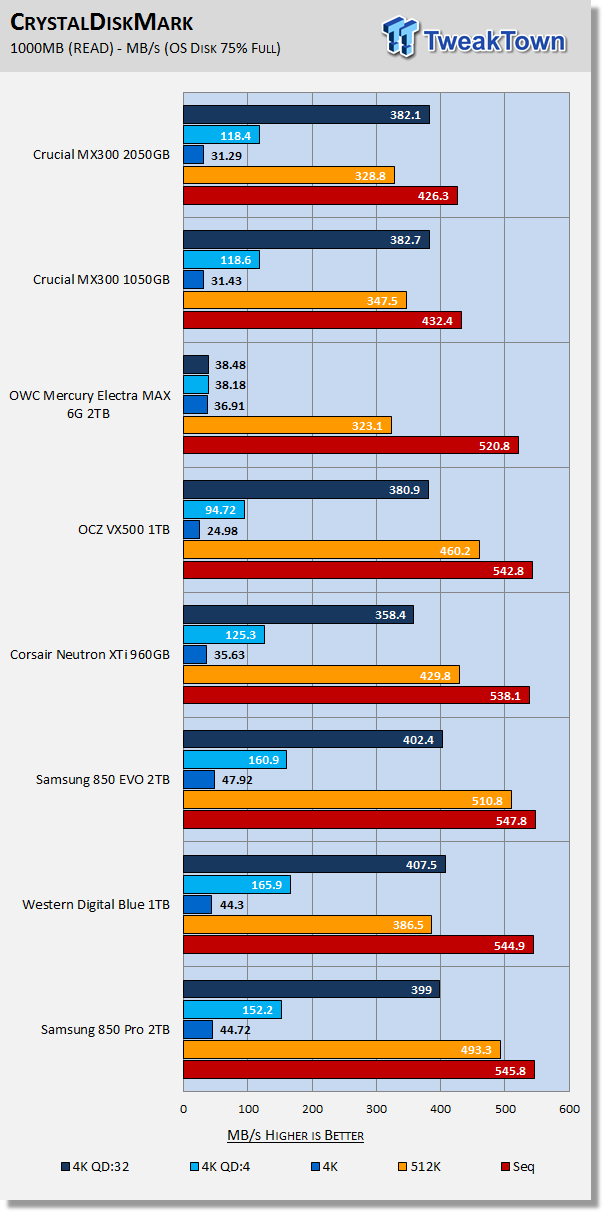
Focusing in on QD1 and QD4 performance we see the MX300 outperforming OCZ's VX500 at both queue depths. At QD4 the MX300 outperforms the Electra MAX because the Electra Max doesn't scale with added queues. Other than that, the MX300 is outperformed by the rest of our test pool.
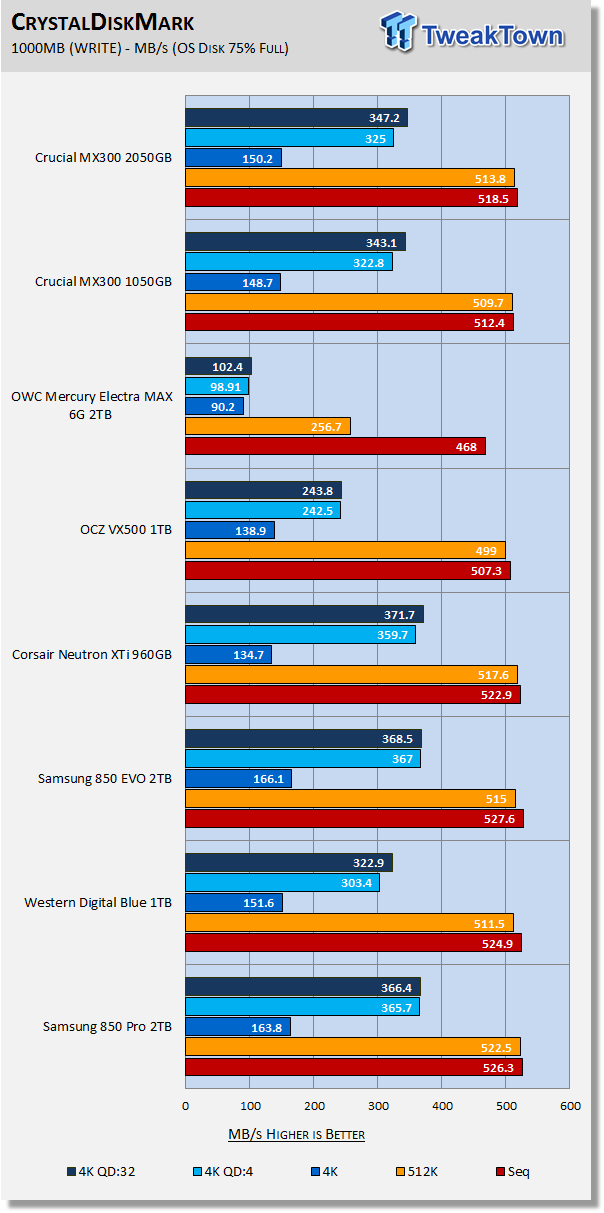
The write-centric MX300 delivers the goods when writing data, whether it be sequential or random. For the most part, we feel that the MX300 delivers write performance that pretty much as good as it gets for a SATA-based SSD.
AS SSD
Version and / or Patch Used: 1.8.5611.39791
AS SSD determines the performance of SSDs. The tool contains four synthetic as well as three practice tests. The synthetic tests are to determine the sequential and random read and write performance of the SSD. We focus on the total score when evaluating with AS SSD.

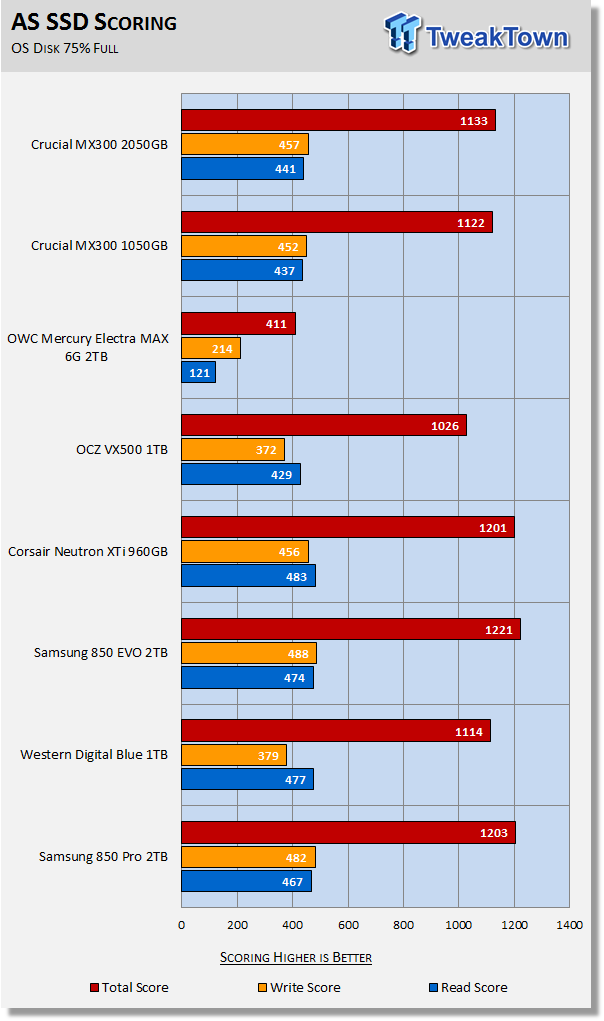
AS SSD is a demanding test. With AS SSD we are looking for a minimum score of 1000 from a TLC SSD. Both capacity points perform excellent; delivering scores of over 1100.
Benchmarks (Trace, OS Volume) - Vantage, PCMark 7 & PCMark 8
Moderate Workload Model
We categorize these tests as indicative of a moderate workload environment.
PCMark Vantage - Hard Disk Tests
Version and / or Patch Used: 1.2.0.0
The reason we like PCMark Vantage is that the recorded traces are played back without system stops. What we see is the raw performance of the drive. This allows us to see a marked difference between scoring that other trace-based benchmarks do not exhibit. An example of a marked difference in scoring on the same drive would be empty vs. filled vs. steady state.
We run Vantage three ways. The first run is with the OS drive 75% full to simulate a lightly used OS volume filled with data to an amount we feel is common for most users. The second run is with the OS volume written into a "Steady State" utilizing SNIA's guidelines. Steady state testing simulates a drive's performance similar to that of a drive that been subjected to consumer workloads for extensive amounts of time. The third run is a Vantage HDD test with the test drive attached as an empty, lightly used secondary device.
OS Volume 75% Full - Lightly Used
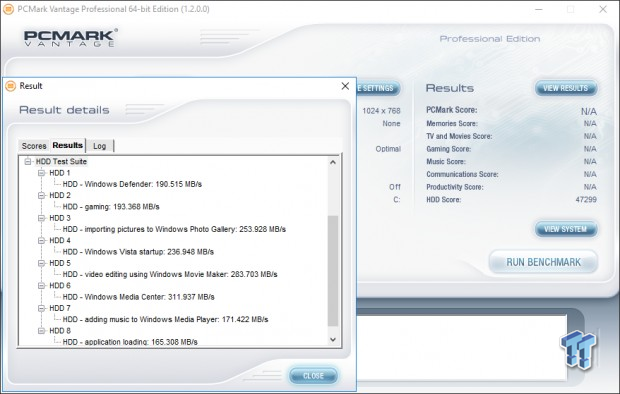
OS Volume 75% Full - Steady State
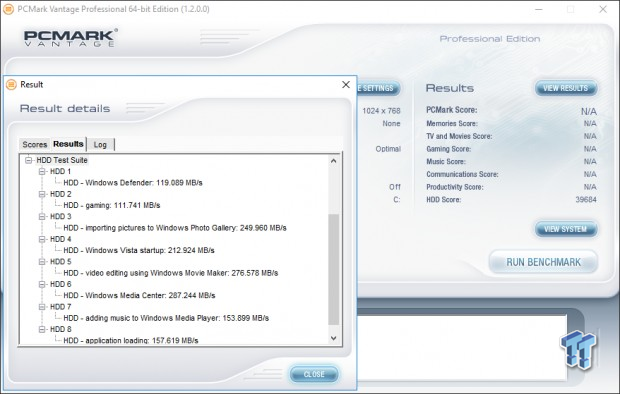
Secondary Volume Empty - FOB
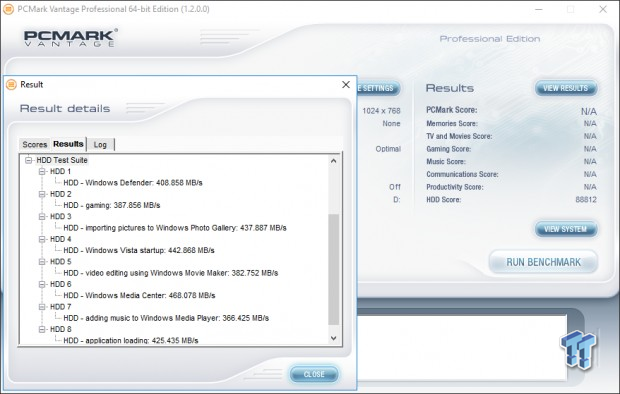
There's a big difference between an empty drive, one that's 75% full/used, and one that's in a steady state.
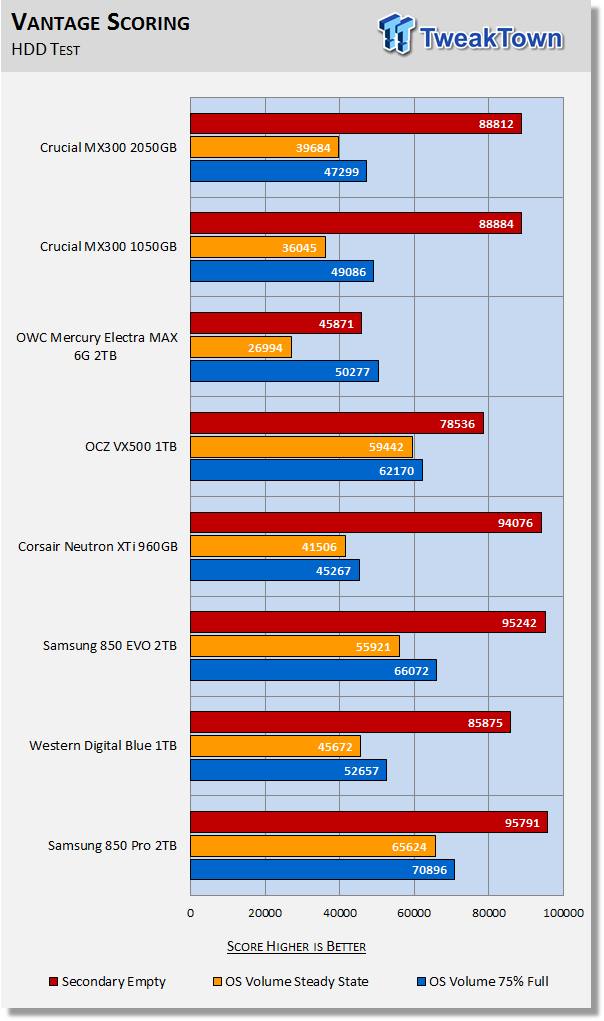
The important scores to pay attention to are "OS Volume Steady State" and "OS Volume 75% full." These two categories are most important because they are indicative of typical of consumer user states. When a drive is in a steady state, it means garbage collection is running at the same time it's reading/writing.
When testing TLC-based SSDs, we like to focus primarily on the drive's 75% full performance because we feel that those purchasing low-cost TLC SSDs will be running light to moderate bursty workloads that will not induce a steady state. At 75% full, the MX300 delivers respectable moderate workload performance, which eclipses the MLC-powered Neutron XTi.
PCMark 7 - System Storage
Version and / or Patch Used: 1.4.0
We will look to Raw System Storage scoring for evaluation because it's done without system stops and, therefore, allows us to see significant scoring differences between drives.
OS Volume 75% Full - Lightly Used
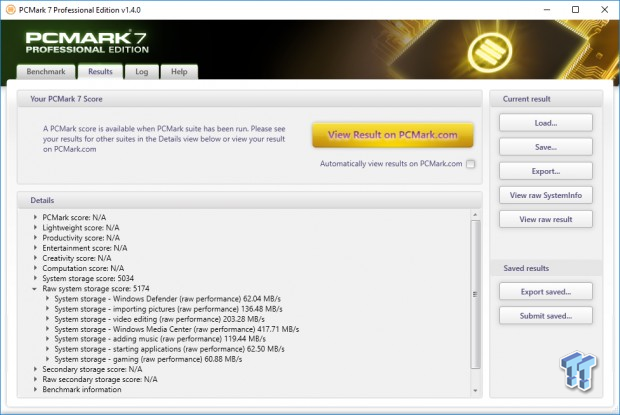
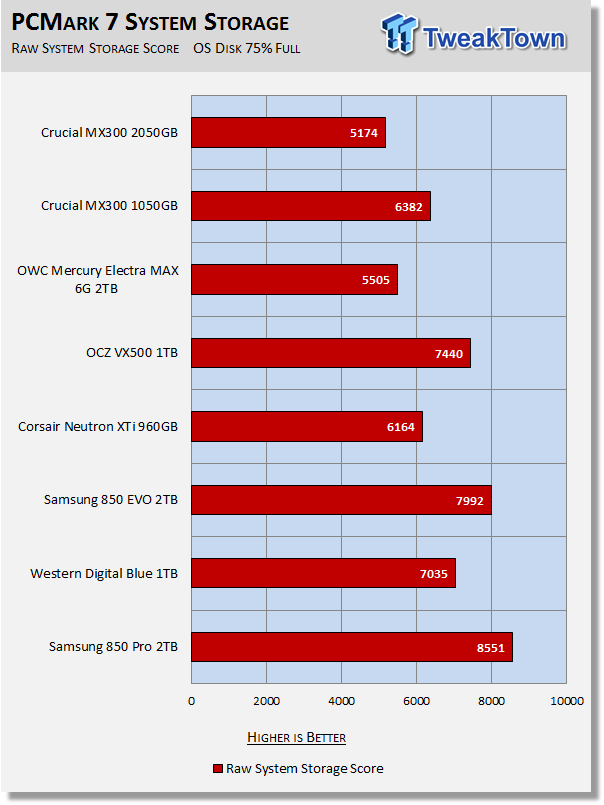
For unknown reasons, the 1050GB MX300 outperforms the 2050GB model significantly. The 1050GB model beats the Neutron XTi and the Electra Max. The 2050GB model finishes in last place.
PCMark 8 - Storage Bandwidth
Version and / or Patch Used: 2.4.304
We use PCMark 8 Storage benchmark to test the performance of SSDs, HDDs, and hybrid drives with traces recorded from Adobe Creative Suite, Microsoft Office, and a selection of popular games. You can test the system drive or any other recognized storage device, including local external drives. Unlike synthetic storage tests, the PCMark 8 Storage benchmark highlights real-world performance differences between storage devices. We focus on the total storage bandwidth when evaluating PCMark 8 results.
OS Volume 75% Full - Lightly Used
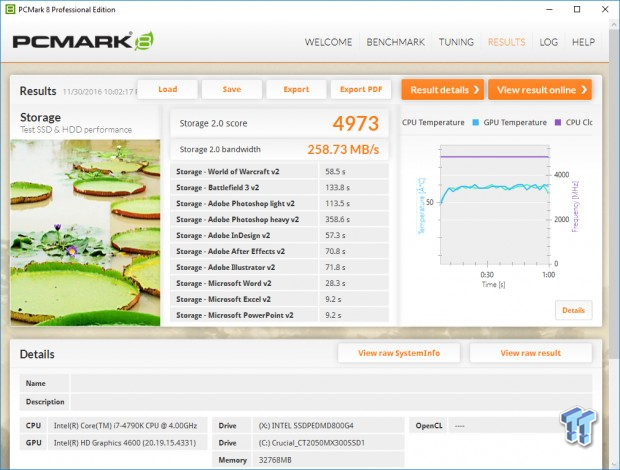
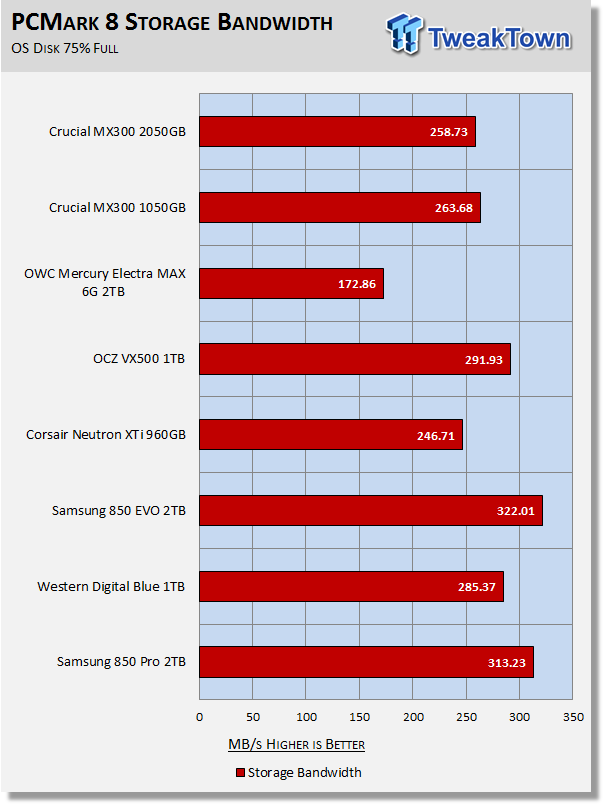
PCMark 8 is the most intensive moderate workload simulation we run. With respect to moderate workloads, this test is what we consider to be the best indicator of a drive's overall performance. The MX300 performs admirably in this test, even managing to outperform the MLC powered Neutron XTi.
Benchmarks (Secondary) – IOPS, Response & Transfers
Iometer – Maximum IOPS
Version and / or Patch Used: Iometer 2014
We use Iometer to measure high queue depth performance. (No Partition)
Max IOPS Read
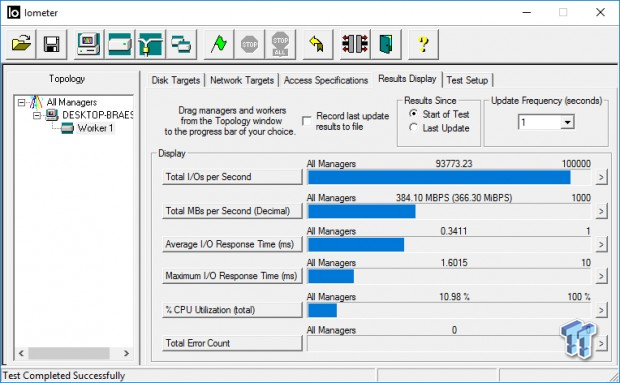
Max IOPS Write
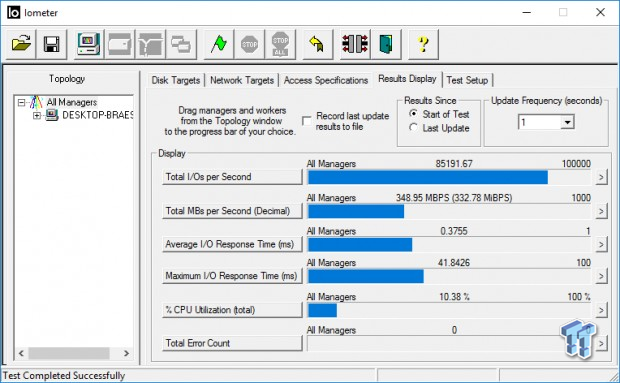
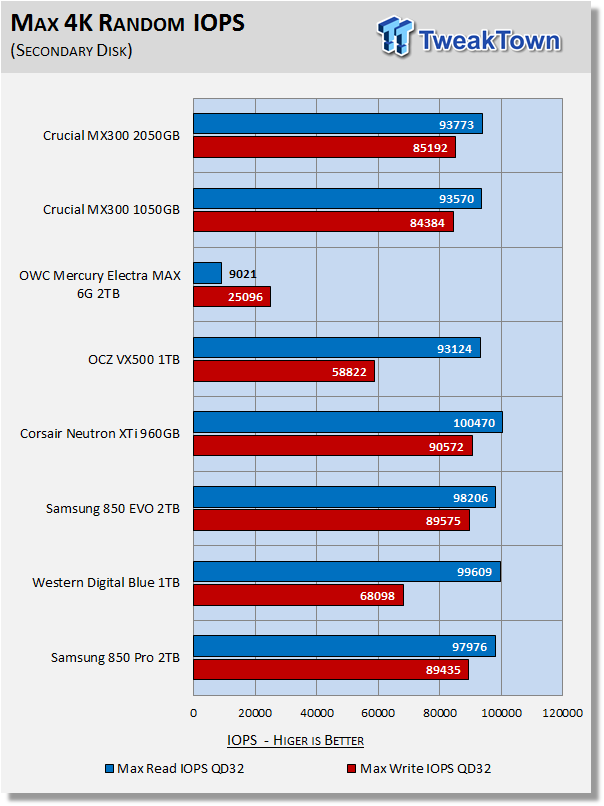
Both capacity points meet or exceed factory specs. The MX300 is able to sustain high write IOPS for the entire 30 seconds of our test, which is something planar-based TLC SSDs like the WD Blue cannot do.
Iometer – Disk Response
Version and / or Patch Used: Iometer 2014
We use Iometer to measure disk response times. Disk response times are measured at an industry accepted standard of 4K QD1 for both write and read. Each test runs twice for 30 seconds consecutively, with a 5-second ramp-up before each test. We partition the drive/array as a secondary device for this testing.
Avg. Write Response
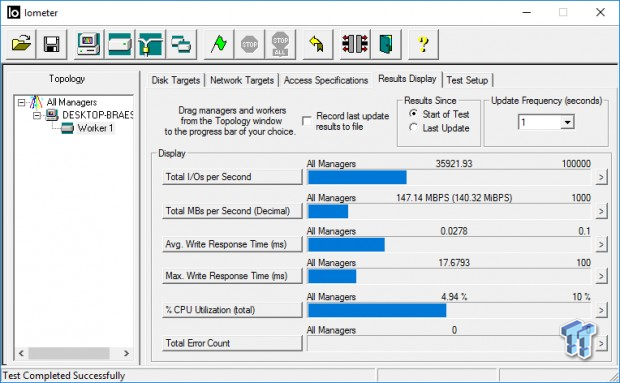
Avg. Read Response
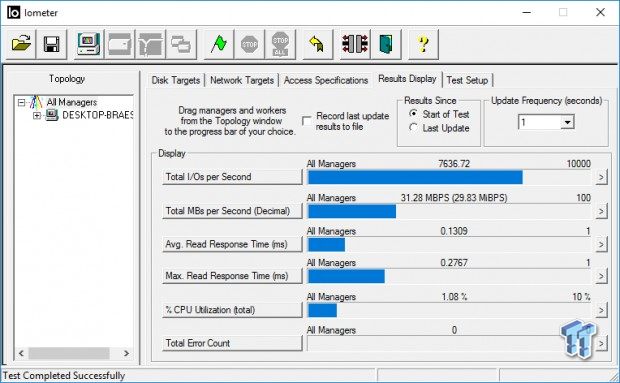
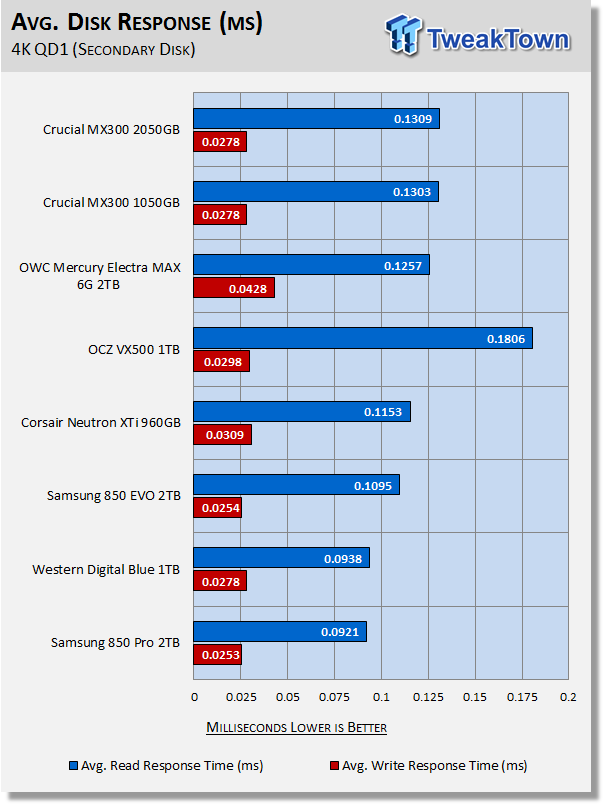
Being write-centric, this plays out as we would expect to see. Excellent write response, below average read response.
DiskBench - Directory Copy
Version and / or Patch Used: 2.6.2.0
We use DiskBench to time a 28.6GB block (9,882 files in 1,247 folders) composed primarily of incompressible sequential and random data as it's transferred from our DC P3700 PCIe NVME SSD to our test drive. We then read from a 6GB zip file that's part of our 28.6GB data block to determine the test drive's read transfer rate. Our system is restarted before the read test to clear any cached data, ensuring an accurate test result.
Write Transfer Rate
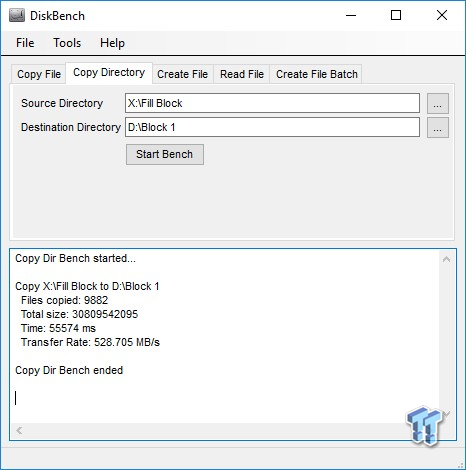
Read Transfer Rate
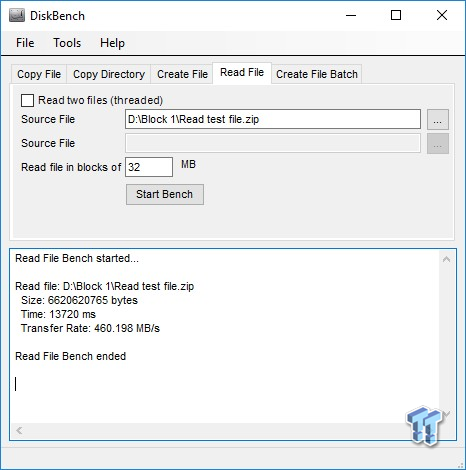
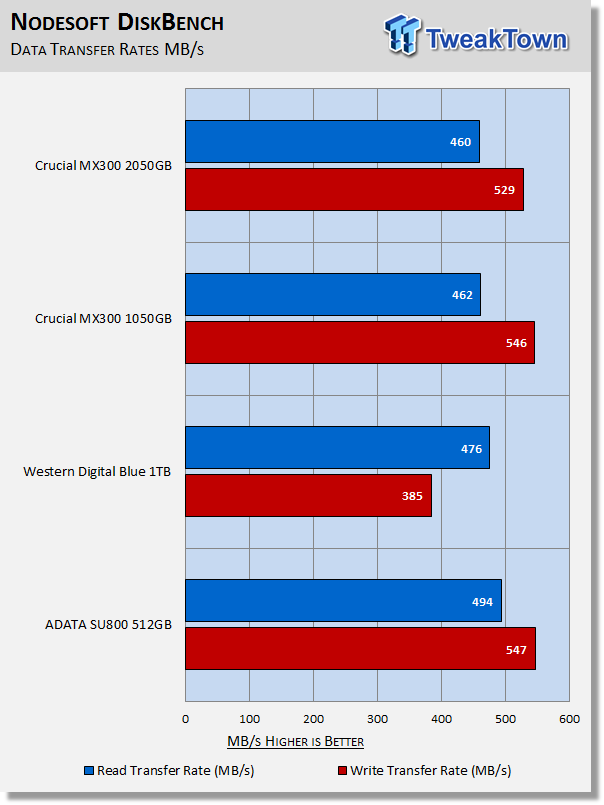
After we upgraded to Windows 10 Anniversary edition, sustained write performance took a massive leap for the better. We cannot compare our results as measured on the previous version of Windows 10. Because of this, we only have two SSDs for direct comparison that were also tested with Windows 10 Anniversary edition.
If we compare the write transfer speed of the planar TLC-based WB Blue to the MX300, we can clearly see one of the advantages that 3D TLC has over planar TLC – sustained write performance. The WD Blue is the perfect comparison because it uses the same Marvell 88SS1074 controller as the MX300.
Benchmarks (Secondary) – PCMark 8 Extended
Futuremark PCMark 8 Extended
Heavy Workload Model
PCMark 8's consistency test simulates an extended duration heavy workload environment. PCMark 8 has built-in, command line executed storage testing. The PCMark 8 Consistency test measures the performance consistency and the degradation tendency of a storage system.
The Storage test workloads are repeated. Between each repetition, the storage system is bombarded with a usage that causes degraded drive performance. In the first part of the test, the cycle continues until a steady degraded level of performance has been reached. (Steady State)
In the second part, the recovery of the system is tested by allowing the system to idle and measuring the performance after 5-minute long intervals. (Internal drive maintenance: Garbage Collection (GC)) The test reports the performance level at the start, the degraded steady-state, and the recovered state, as well as the number of iterations required to reach the degraded state and the recovered state.
We feel Futuremark's Consistency Test is the best test ever devised to show the true performance of solid state storage in an extended duration heavy workload environment. This test takes on average 13 to 17 hours to complete and writes somewhere between 450GB and 14,000GB of test data depending on the drive. If you want to know what an SSDs steady state performance is going to look like during a heavy workload, this test will show you.
Here's a breakdown of Futuremark's Consistency Test:
Precondition phase:
1. Write to the drive sequentially through up to the reported capacity with random data.
2. Write the drive through a second time (to take care of overprovisioning).
Degradation phase:
1. Run writes of random size between 8*512 and 2048*512 bytes on random offsets for 10 minutes.
2. Run performance test (one pass only).
3. Repeat 1 and 2 for 8 times, and on each pass increase the duration of random writes by 5 minutes.
Steady state phase:
1. Run writes of random size between 8*512 and 2048*512 bytes on random offsets for 50 minutes.
2. Run performance test (one pass only).
3. Repeat 1 and 2 for 5 times.
Recovery phase:
1. Idle for 5 minutes.
2. Run performance test (one pass only).
3. Repeat 1 and 2 for 5 times.
Storage Bandwidth
PCMark 8's Consistency test provides a ton of data output that we use to judge a drive's performance.
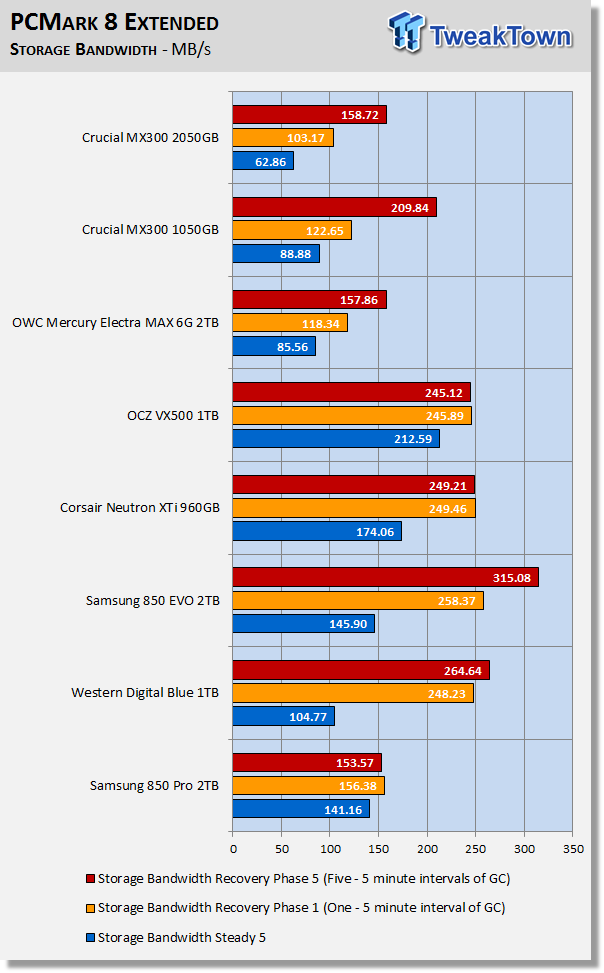
We consider steady state bandwidth (the blue bar) our test that carries the most weight in ranking a drive/arrays heavy workload performance. Performance after Garbage Collection (GC) (the orange and red bars) is what we consider the second most important consideration when ranking a drive's performance.
When evaluating TLC-based SSDs, we like to focus on recovery performance more than steady-state. Our reasoning is that consumers who purchase low-cost TLC SSDs aren't likely going to be running workloads intense enough to induce a steady-state. Based on the recovery bandwidth, the MX300 gives us middle of the road heavy workload performance. In fact, the MX300 manages better recovery performance than the mighty Samsung 850 Pro 2TB.
Bandwidth at Test Phase
We chart our test subject's storage bandwidth as reported at each of the test's 18 trace iterations. This gives us a good visual perspective of how our test subjects perform as testing progresses. This chart sheds more light on how the drives perform as they progress through the testing phases.
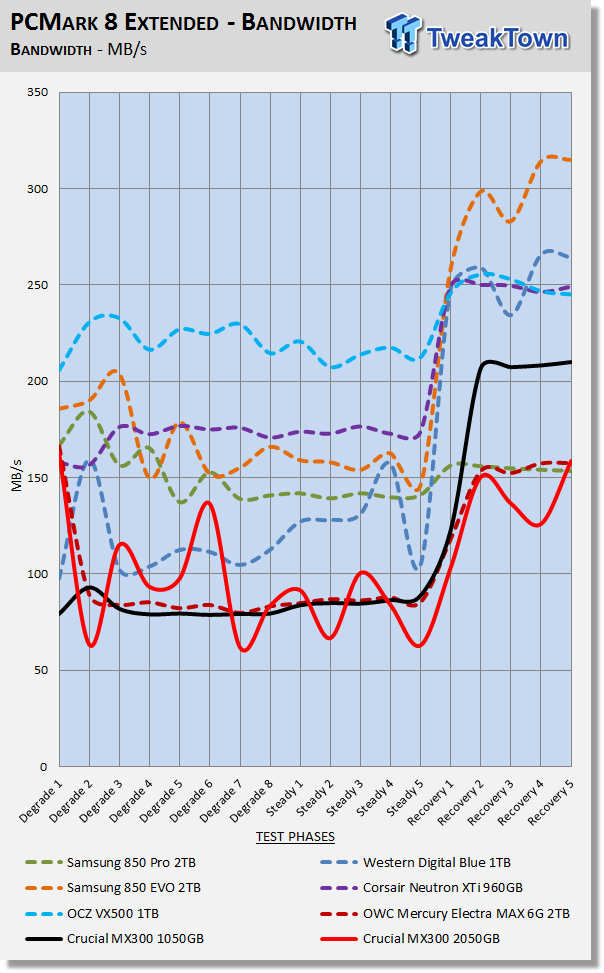
The 2050GB MX300 displays significant variability in comparison to the 1050GB model.
Total Access Time (Latency)
We chart the total time the disk is accessed as reported at each of the test's 18 trace iterations.
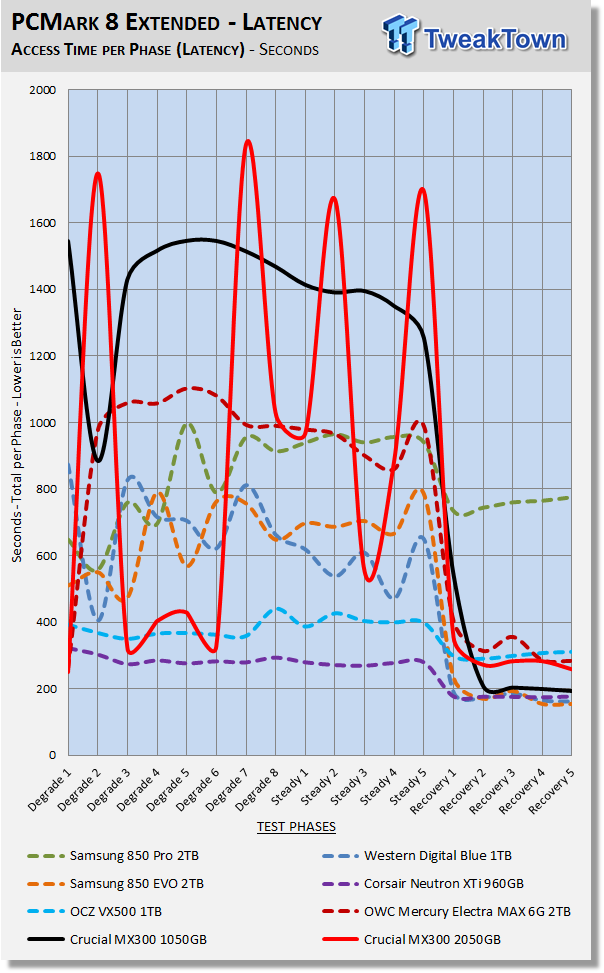
Low latency translates to the real-world as snappiness.
Disk Busy Time
Disk Busy Time is how long the disk is busy working. We chart the total time the disk is working as reported at each of the tests 18 trace iterations.
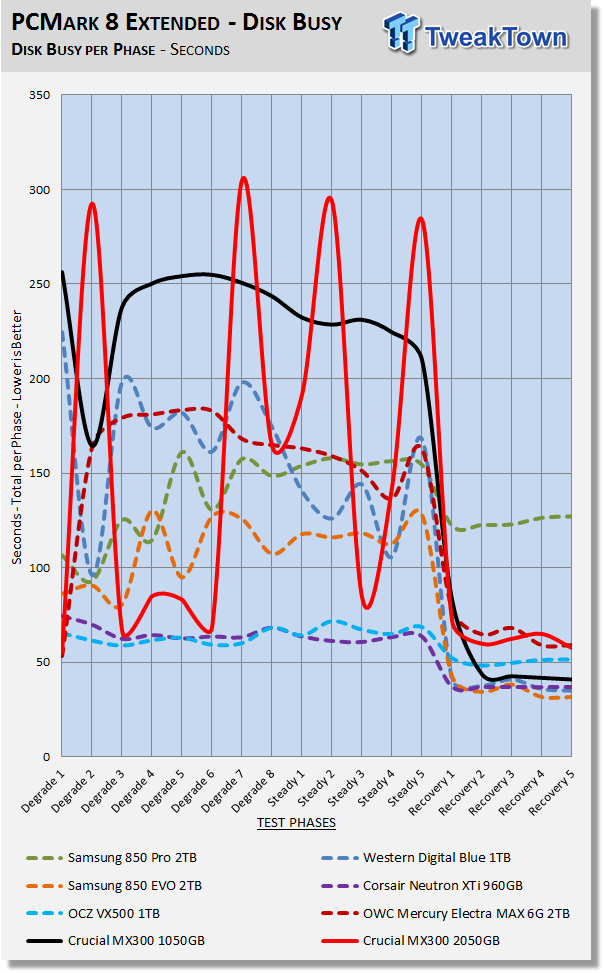
When latency is low, disk busy time is low as well.
Data Written
We measure the total amount of random data that our test drive/array is capable of writing during the degradation phases of the consistency test. Pre-conditioning data is not included in the total. The total combined time that degradation data is written to the drive/array is 470 minutes. This can be very telling. The better a drive/array can process a continuous stream of random data; the more data will be written.
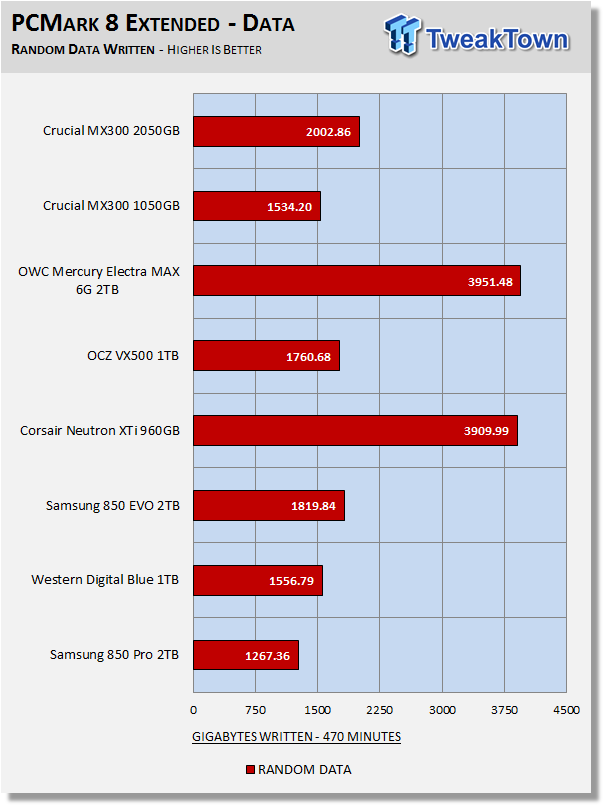
Overprovisioning and write latency are the biggest factors that determine the outcome of this portion of the test. The MX300 has no overprovisioning, the EVO has a little, and the Electra Max has a ton. This is why the pecking order shakes out like it does.
Benchmarks (Secondary) – 70/30 Mixed Workload
70/30 Mixed Workload Test (Sledgehammer)
Version and / or Patch Used: Iometer 2014
Heavy Workload Model
This test hammers a drive so hard we've dubbed it "Sledgehammer." Our 70/30 Mixed Workload test is designed to simulate a heavy-duty enthusiast/workstation steady-state environment. We feel that a mix of 70% read/30% write, full random 4K transfers best represents this type of user environment. Our test allows us to see the drive enter into and reach a steady state as the test progresses.
Phase one of the test preconditions the drive for 1 hour with 128K sequential writes. Phase two of the test runs a 70% read/30% write, full random 4K transfer workload on the drive for 1 hour. We log and chart (phase two) IOPS data at 5-second intervals for 1 hour (720 data points). 60 data points = 5 minutes.
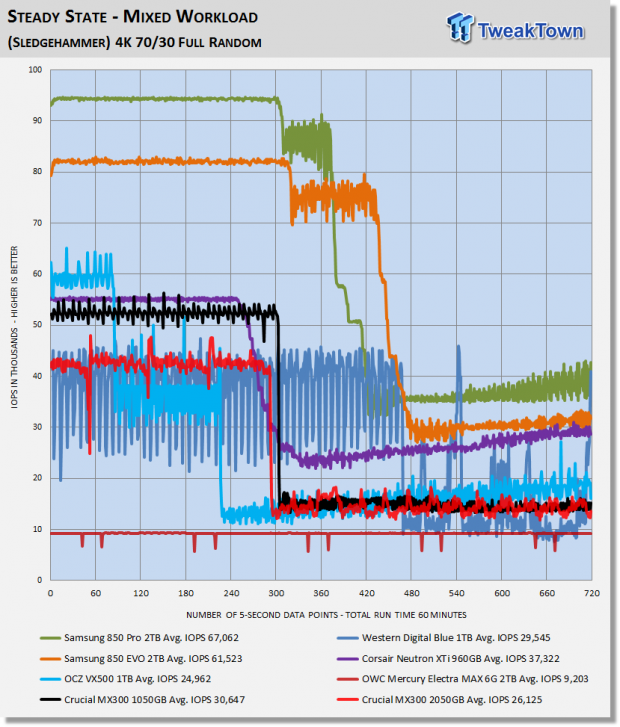
What we like about this test is that it reflects reality. Everything lines up, as it should. Consumer drives don't outperform Enterprise-Class SSDs that were designed for enterprise workloads. Consumer drives based on old technology are not outperforming modern Performance-Class SSDs, etc.
The 1050GB model does a bit better than the 2050GB model. Overall both deliver above average heavy workload performance.
Maxed-Out Performance (MOP)
This testing is just to see what the drive is capable of in a FOB (Fresh Out of Box) state under optimal conditions. We are utilizing empty volumes of Windows 10 and Windows Server 2008 R2 64-bit for this testing.
Windows Server 2008 R2 MOP
Crucial MX300 1050GB
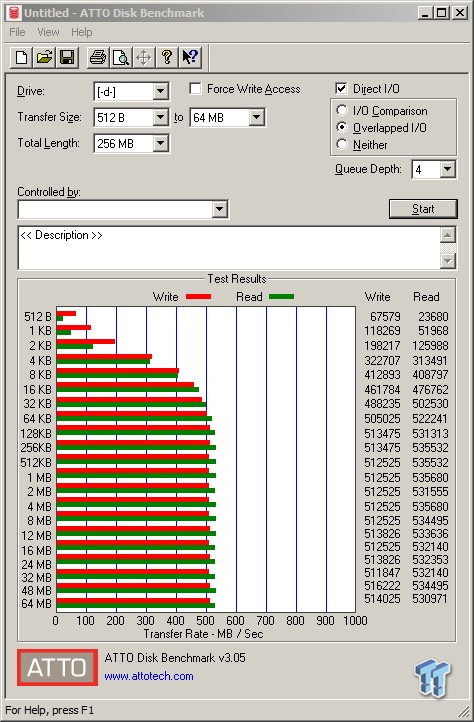
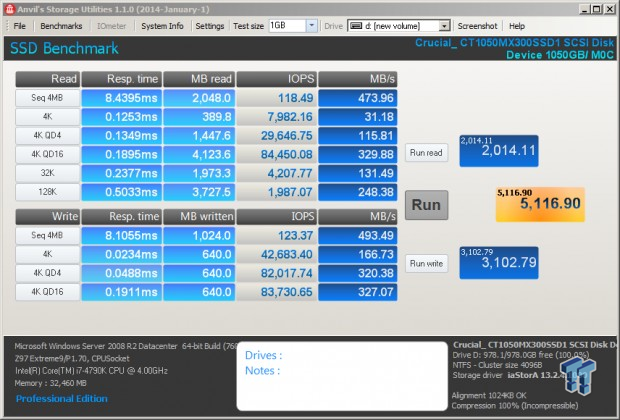
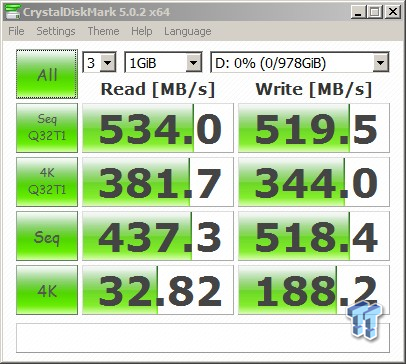
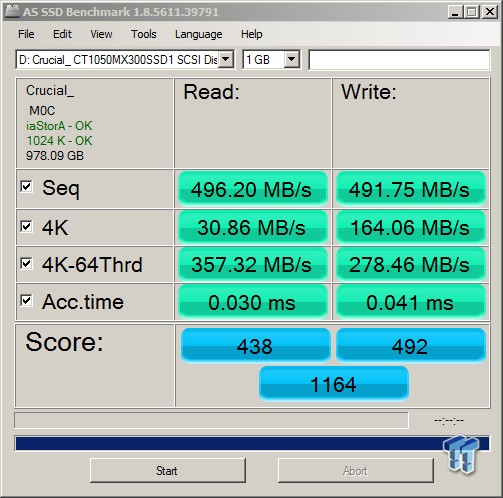
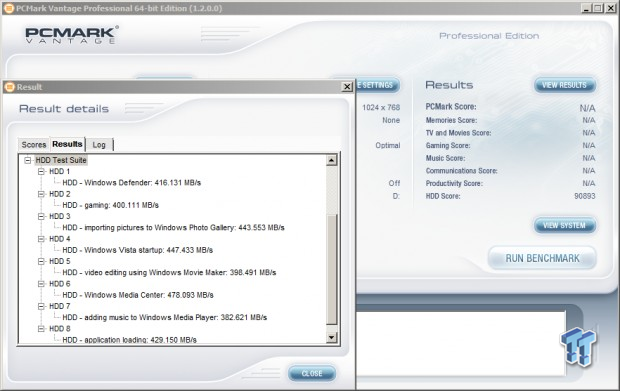
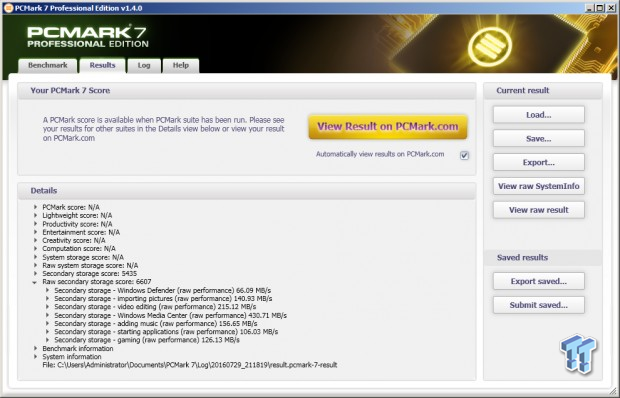
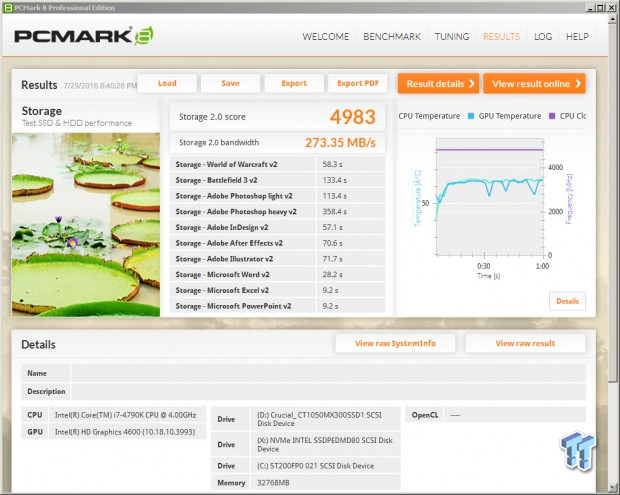
Windows Server 2008 R2 MOP
Crucial MX300 2050GB
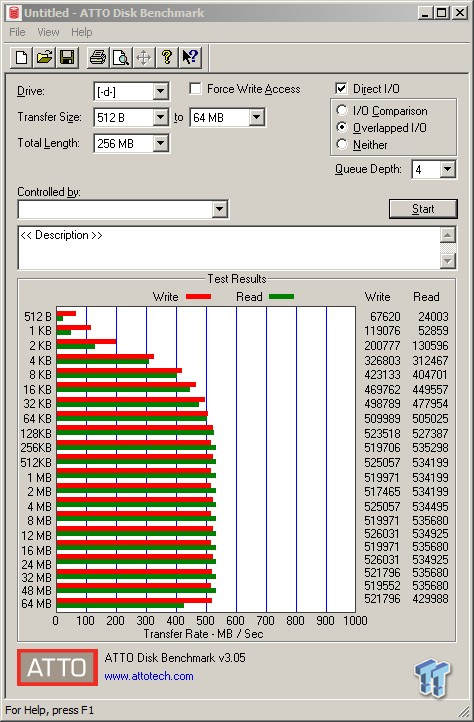
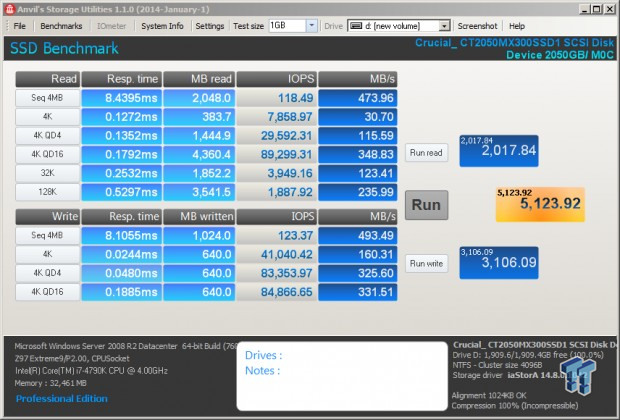
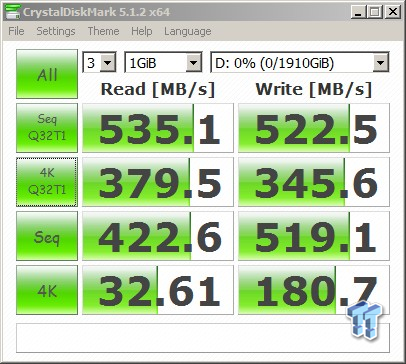
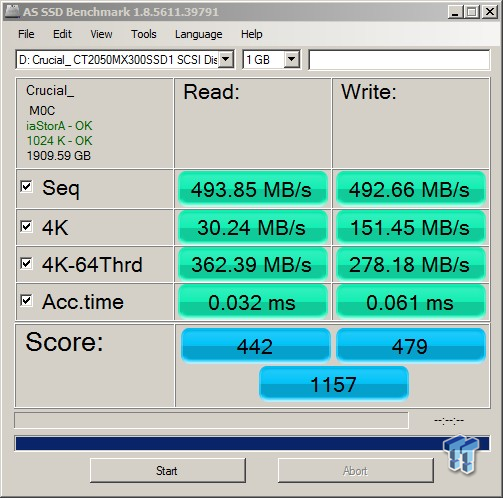
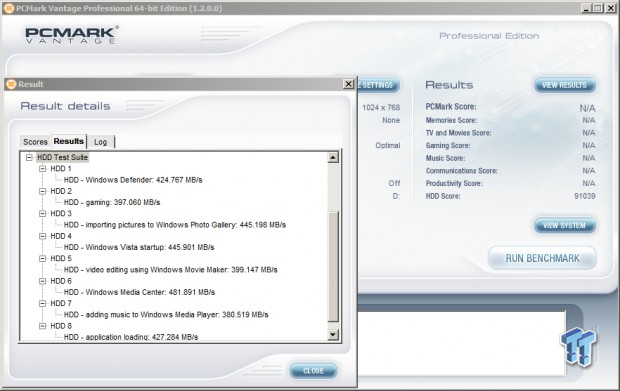
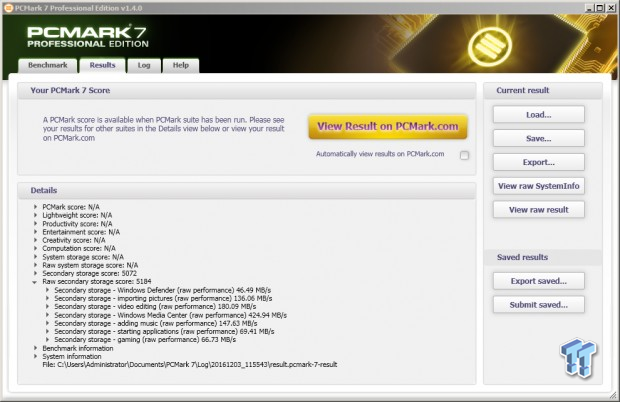
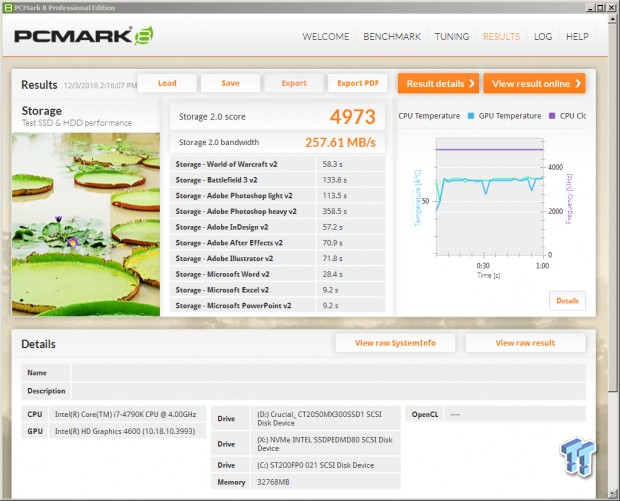
Final Thoughts
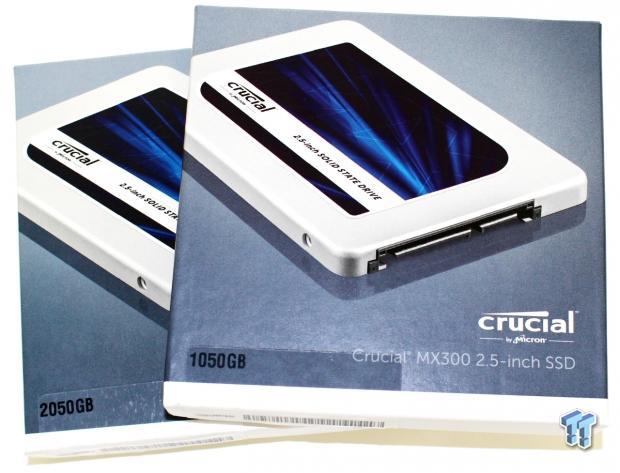
Throughout our testing, Crucial's MX300 had no problems exceeding the minimums we have in place for TLC-based SSDs. The MX300 really delivered the goods as demonstrated by our transfer testing where it was able to sustain a 28.6GB transfer at well over 500MB/s. This is exceptional performance for any SATA based SSD, let alone a TLC -based SSD. The MX300 proved to be a write-centric SSD which bodes well for storing and transferring large amounts of data, which will be common practice on any high capacity storage device.
As we see it, Crucial's MX300 is the best path to high-capacity mechanical free storage. Even with SSD pricing on the rise, the MX300 is still supremely affordable in high capacities. While the MX300 isn't the best performing SSD on the market, the performance it offers is good enough that you would be hard pressed to notice a difference between it and far more expensive high-capacity SATA SSDs.
Crucial adds in additional value when you purchase an MX300 SSD. Included for free with the drive is a copy of Acronis HD which the best cloning software available. That is a huge value add, as is Crucial's Storage Executive software suite which gives you drive management and caching capabilities that are hugely beneficial for keeping your SSD running its best. Additionally, the MX300 gives you more capacity than any other terabyte-class SSDs on the market.
Crucial's MX300 series SSDs deliver an excellent SSD user experience at a very low price point, which is why it is TweakTown recommended.
Pros:
- Price Point
- Write Performance
- Build Quality
- Free Software
Cons:
- Workload performance

| Performance | 88% |
| Quality | 96% |
| Features | 98% |
| Value | 99% |
| Overall | 95% |
The Bottom Line: Free yourself from mechanical storage with Crucial's affordable, high-capacity MX300 SSDs.
PRICING: You can find products similar to this one for sale below.
 United
States: Find other tech and computer products like this
over at Amazon.com
United
States: Find other tech and computer products like this
over at Amazon.com
 United
Kingdom: Find other tech and computer products like this
over at Amazon.co.uk
United
Kingdom: Find other tech and computer products like this
over at Amazon.co.uk
 Australia:
Find other tech and computer products like this over at Amazon.com.au
Australia:
Find other tech and computer products like this over at Amazon.com.au
 Canada:
Find other tech and computer products like this over at Amazon.ca
Canada:
Find other tech and computer products like this over at Amazon.ca
 Deutschland:
Finde andere Technik- und Computerprodukte wie dieses auf Amazon.de
Deutschland:
Finde andere Technik- und Computerprodukte wie dieses auf Amazon.de
What's in Jon's PC?
- CPU: AMD Ryzen 7800X 3D
- MOTHERBOARD: GIGABYTE AORUS Master X670E
- RAM: Kingston Fury Renegade 7200MHz 32GB
- GPU: ZOTAC AMP Extreme GeForce RTX 4090
- SSD: Crucial T700 2TB Gen5
- OS: Windows 11 Pro
- COOLER: Lian Li Galahad 360 AIO
- CASE: Lian Li Lancool III
- KEYBOARD: Corsair K65 RGB Mini
- MOUSE: SteelSeries AEROX 5 Wireless
- MONITOR: ASUS ROG Strix PG27AQN 360Hz 1440p ULMB2
Similar Content
Related Tags

